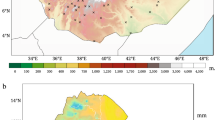Abstract
The Natural Resources Conservation Service measures high elevation snowpack manually at snow courses across the western US. In addition to supporting the production of seasonal snowmelt-driven streamflow forecasts, this long-term dataset is widely used throughout the research community to study historical climatic change impacts. Therefore it is critical to understand what factors may affect the quality of the measurements, especially if those non-climatic factors possess long-term trends. For example, the snowpack measurement dates are nominally the first and fifteenth of the month although they actually average approximately 2 days earlier. This study found that the variability of measurement dates are determined by, 1) the epoch of the measurement, 2) the day of the week of the nominal measurement date, 3) the presence or absence of snow at the site and 4) if the measurement is for the first or the fifteenth of the month. The measurement date is less variable if snow is absent from the site. Mid-month data are collected closer to the nominal measurement date, and first of month data have a greater early bias. Since 1957, there has been a stronger aversion to collecting data on Fridays and weekends. Measurements are taken today on average 1.35 days earlier than they were before 1957. The effect on measurement bias depended on the time of year and was generally less than 5 % of the measurement. Therefore, changes in measurement date only slightly mask one’s ability to accurately detect long-term climatic trends.










Similar content being viewed by others
References
Daly C, Gibson WP, Taylor GH et al (2007) Observer bias in daily precipitation measurements at United States cooperative network stations. Bull Am Met Soc 88:899–912
Folland CK, Parker DE (1995) Correction of instrumental biases in historical sea surface temperature data. Q J Roy Meteorol Soc 121:319–367
Janis MJ (2002) Observation-time-dependent biases and departures for daily minimum and maximum air temperatures. J Appl Meteorol 41:588–603
Julander RP (2005) An analysis of the timing of snow course measurement and the potential error compared to April 1 measurements in Utah. In: Proceedings of the western snow conference, Great Falls, Montana, 11–14 April 2005
Julander RP, Bricco M (2006) An examination of external influences imbedded in the historical snow course data of Utah. In: Proceedings of the western snow conference, Las Cruces, New Mexico, 17–20 April 2006
Karl TR, Williams CN Jr, Young PJ et al (1986) A model to estimate the time of observation bias associated with monthly mean maximum, minimum, and mean temperature for the United States. J Clim 25:145–160
McCabe GJ, Clark MP (2005) Trends and variability in snowmelt runoff in the western United States. J Hydrometeor 6:476–482
McCabe GJ, Clark MP, Hay LE (2007) Rain-on-snow events in the western United States. Bull Am Met Soc 88:319–328
Mote PW (2006) Climate-driven variability and trends in mountain snowpack in western North America. J Clim 19:6209–6220
Mote PW, Hamlet AF, Clark MP et al (2005) Declining mountain snowpack in western North America. Bull Am Met Soc 86:39–49
Pagano TC, Garen DC, Perkins TR et al (2009) Daily updating of operational statistical seasonal water supply forecasts for the western US. J AM Water Resour As 45:767–778
Smith TM, Reynolds RW (2002) Bias corrections for historical sea surface temperatures based on marine air temperatures. J Clim 15:73–87
Viney NR, Bates BC (2004) It never rains on Sunday: the prevalence and implications of untagged multi-day rainfall accumulations in the Australian high quality data set. Int J Climatol 24:1171–1192
Acknowledgments
This work was partially completed while the author was an operational seasonal water supply forecaster in Portland, Oregon, United States, at the National Water and Climate Center (NWCC) of the US Department of Agriculture’s (USDA) Natural Resources Conservation Service (NRCS). The author was recently supported by the Water Information Research and Development Alliance (WIRADA), a collaboration of CSIRO and the Australian Bureau of Meteorology to transfer the research to operations.
Author information
Authors and Affiliations
Corresponding author
Rights and permissions
About this article
Cite this article
Pagano, T.C. Quantification of the influence of snow course measurement date on climatic trends. Climatic Change 114, 549–565 (2012). https://doi.org/10.1007/s10584-012-0446-0
Received:
Accepted:
Published:
Issue Date:
DOI: https://doi.org/10.1007/s10584-012-0446-0




